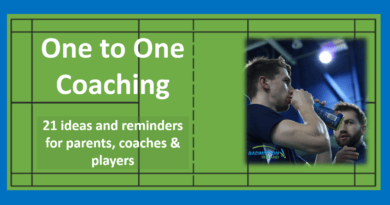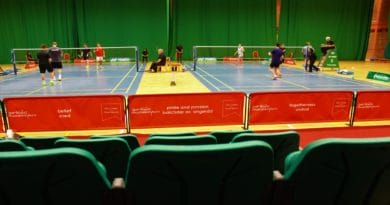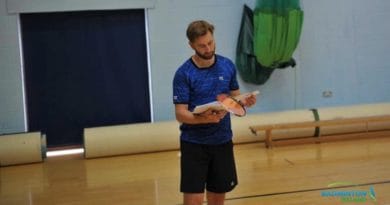Coach Questions : technical models for development
Recently a coach sent me these questions
-
Should coaches be looking to implement badminton technical models & what flexibility do they have?
-
What information is out there that could inform coaches of models to use?
– – – – – – – – – – – – – – – – – – – – – – – – – – –
Have ever asked this or something similar?
How would you reply to the coach and what would be your key advice?
How sure would you be of your answer?
or
Like me would you find some aspects tough?
– – – – – – – – – – – – – – – – – – – – – – – – – – –
What happened next
I emailed the coach back and asked if they had written any ideas or bullet points, to try and work through the question. I also asked what interested them about this subject.
In part I was trying to create some thinking space for myself, should I choose to reply.
They emailed back within 24 hrs and said that they hadn’t written anything down yet. They said that they had been searching for something that outlined essential beginner skills, something that gave them guidelines to follow. Guidelines rather than specific Do’s & Don’ts.
They wanted to know how to ensure that the aspects they encouraged prevented or limited future errors and that their players had the “best start” that they could give them.
Interestingly, they also mentioned that after several discussions with other coaches they felt that some were too prescriptive in terms of what should be “taught” to young players.
I closed the email and started to worry
Has anyone published information concerning a set of core techniques that all novice players should be introduced to?
– – – – – – – – – – – – – – – – – – – – – – – – – – –
I’ve split the questions into smaller chunks to help, I hope
1A – Should coaches be following and implementing badminton technical models?
1C – What information is out there that could inform coaches of the model to use, does any exist?
1D – How can coaches create their own model?
– – – – – – – – – – – – – – – – – – – – – – – – – – –
The answers, well, my attempts, but first a Warning!
The skill of the coach is how to apply any technical models they use in a context that applies to the player(s) in front of them.
To adhere to a technical model or coaching methodology without considering the player is not coaching. It’s just blind delivery and should be considered as bad coaching! There are so many “it depends” that the model you follow should only be part of your overall strategy when delivering the information.
Do you expect the technical model to be a list of strokes & movements?
Or
Do you want the model to contain detailed technical elements and components?
Or
Do you require technical “sign posts” and descriptions that you have to translate into practice?
– – – – – – – – – – – – – – – – – – – – – – – – – – –
1A – Should coaches be following and implementing badminton technical models?
The quick answer is yes, but be careful 🙂
Coaches need to have a set of technical criteria that they believe underpin most striking and moving skills
However, it’s how they are used that is critical
I recommend that a technical model isn’t a list of strokes & movements, but a series of essential components that describe the hitting & moving skills
An effective and useful technical model will contain statements (recommendations) that may be seen as nearly complete strokes/movements. There could also be other smaller elements that do not initially trigger an image of whole movements but form smaller critical aspects of larger more complex movements. There will be some examples in the posts I later link to.
You may be asking how and where do I find this information, we can also address this later.
These technical models apply most importantly to the coaching of beginner/novice players in the first 3 training years that they engage with badminton. I’m assuming that the coach was asking about players aged between 8 – 13 yrs old.
But why follow a model?
It’s during the early years that the underpinnings (especially the technical elements) need to be established for these reasons
- To make changes later will be difficult and stressful
- The development of future strokes may be hampered if underlying problems exist
- To achieve maximum power safely for striking, moving and stopping
Of course, coaches can follow any theory that they wish, that is unless they work within a structure (model) set by a club, County, or National Governing body.
If you work within guidelines, I recommend that you “test and review” them frequently with the aim of understanding how they influence players. Assess if the guidelines hold true when applied to the players you work with. Are they effective over a period of time in producing those skills that you believe are important? More importantly, does the product allow future development, and do you then spend less time “correcting” or trying to change what you see.
 You may decide not to!
You may decide not to!
Alternatively, you may decide that following any model or guidelines with young novice players is not something that you believe in. Is this your thought?
Do you feel that initially, players should experience badminton without any guidelines, directions, or prescribed practices? I’ve heard some people suggest that this is a more enjoyable way of initially experiencing badminton and that enjoyment must be uppermost with these players.
If you believe this then I would really like to hear your thoughts and understand how you structure the sessions. I also believe that enjoyment is important, however, I do aim to follow technical guidelines (signposts for success/improvements).
Even if you don’t consciously follow a set of guidelines or adhere to a technical model you are creating the environment (the badminton session) and therefore experiences players have. The technical skills they develop (the ways of striking and movements) will start to form anyway.
Can I ask you this question
Do you like the striking & moving techniques that form ‘naturally’ without any coach direction or guidance?
I am not suggesting that you coach in a prescriptive, directive manner and be constantly talking about the criteria to the players: that would be foolish
– – – – – – – – – – – – – – – – – – – – – – – – – – –
1B – Should coaches allow players flexibility within these models?
The quick answer is yes, certainly, yes.
Any technical models that specify badminton techniques need to have a degree of flexibility within them. You may have to consider how much flexibility, as this could vary. You may also find that your initial interpretation is not exactly what the author intended.
I recommend that once you find a model, you contact the author and discuss the underpinning rationale – challenge them if required
The flexibility in these “technical basics” I like (see below) comes from the aspect that they aren’t strokes or whole movements but essential (in my view) components of strokes and movements. Therefore they will appear in a variety of strokes/movements to a greater or lesser degree in terms of criticality.
You will be required to be flexible
- as the player develops physically
- depending on the rally situation
- the style of tactical play
- as your badminton knowledge develops
How you coach or teach these components is the real challenge, you will require flexibility in delivery
You will also need an underpinning knowledge base in order to make your choices
– – – – – – – – – – – – – – – – – – – – – – – – – – –
1C – What information is out there that could inform coaches of the model to use?
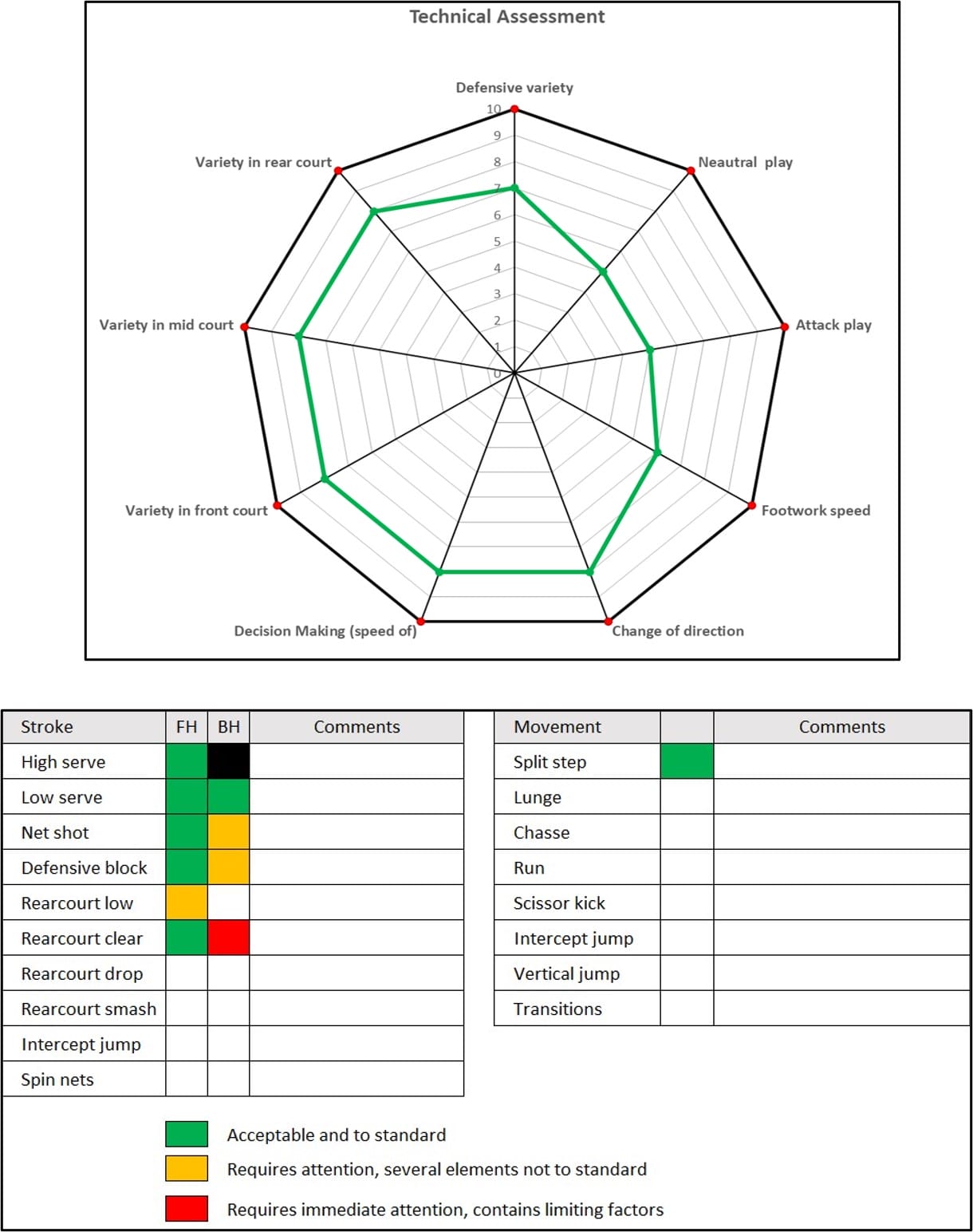 I’ve only ever found one model for technical development and only ever met one person who was interested and capable of helping with this question. I’ve said more about it and linked to some posts at the bottom of this section.
I’ve only ever found one model for technical development and only ever met one person who was interested and capable of helping with this question. I’ve said more about it and linked to some posts at the bottom of this section.
The question I was asked was specifically targeted at technical skills.
I assume that the coach was looking for guidance regarding the coaching of novice players aged 7-13 years old. Again I assumed that they were seeking advice on what elements to practice that would increase the success of future development i.e. what are the “early” skills that have been proven to increase future success, not cause injury, and are “error proofed”.
I have seen and heard of a “Player Characteristic Model”, PCM’s. However, these often list many elements (the attributes that are considered necessary) that are required to describe a model player at various stages of development.
The one I have studied sets out a list of statements across a range of headings such as lifestyle, technical, tactical, physical, psychological. Each heading is split into 20+ elements. The coach and player score each element out of 10. The concept is that by fragmenting these skills/abilities and having both player and coach scores, then an assessment is created to help review and progress. The coach then works out a program to improve each quality.
Other guidelines focus on naming a series of strokes and movements applicable to that playing standard. The coach then rates each one in terms of it’s closeness to the model guidelines. Again the concept is that this identifies a target for comparison.
Neither of these concepts are technical development models in my opinion.
What badminton technique models do you know of?
The information I like

This series of posts covers the information that I follow when considering what the technical Playing Basics could be. I would be very interested in knowing your thoughts.
The model I like to use contains statements that describe the components of hitting and moving skills. Some components may look similar to strokes and movements you know by a specific name, whilst others will refer to small but critical aspects of larger more complex movements.
The content is always in my mind, especially when working with young players.
My task is to design lots of practices and ensure that they include these striking and moving basics. My goal is for the practice/task to introduce and develop the elements without the need for me to continually reinforce them through verbal instructions. Yes, they may be required at the start and used with some good demos, but afterwards the practice, the task is important for me.
I find that there is an enormous amount of flexibility for me within each of the technical playing basics. You may disagree, if so, I’d love to chat with you.
Are you surprised that when you read the information you don’t read the names of strokes but you can see lots of them in your mind when you picture the ‘basic’
– – – – – – – – – – – – – – – – – – – – – – – – – – –
1D – How can coaches create their own technical model?
It would be great if coaches did work to create their own badminton technical models to follow. Alternatively, they may choose to consider the existing information and challenge it.
You must try and generate your list of “essential” technical basics. Remember, these are not a list of strokes.
The task of considering what, if any, technical elements exist is certainly challenging, but I promise that you will find it rewarding
Ask yourself these questions for any models or lists you create
1. Do the elements you’ve listed appear as part of different stokes/movement skills?
2. Could they be introduced in their own right?
3. Is there a possibility of using them to “error proof” players against inappropriate techniques?
4. What do other coaches say about your list?
– – – – – – – – – – – – – – – – – – – – – – – – – – –
Be aware that not only are technical models important
There are also the psychosocial, tactical and physical skills that need frameworks
– – – – – – – – – – – – – – – – – – – – – – – – – – –
Here is another question that came from a chat with a friend
- Do coaches place an over importance on technical aspects, compared to tactical and physical ones?
- Does the balance (of importance and time) vary across age ranges and standards?
Take a moment and think about how much isolated technical coaching you do with your players.
Are your sessions slanted towards improving technical aspects before tactical?


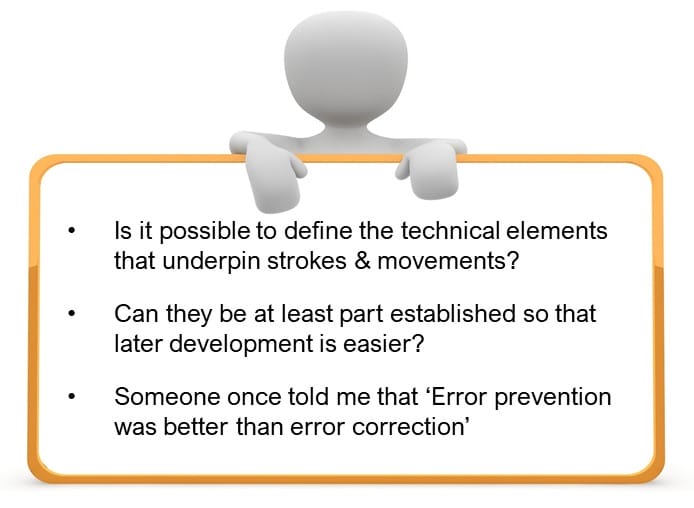
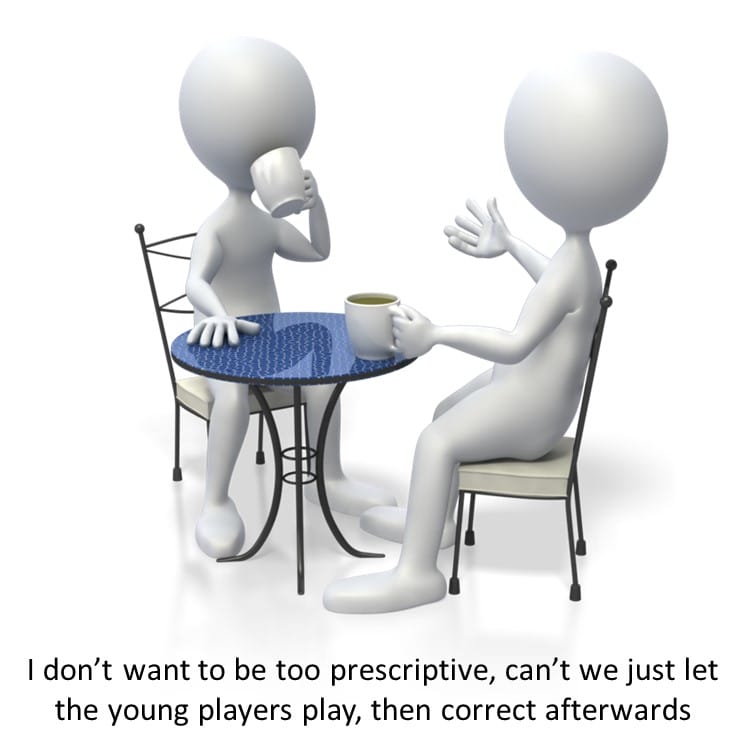 You may decide not to!
You may decide not to!
